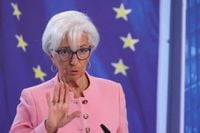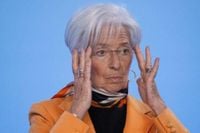The European Central Bank (ECB) is poised to announce another interest rate cut on Thursday, April 17, 2025, as economic pressures from U.S. tariffs and a strengthening Euro weigh heavily on the Eurozone. The anticipated reduction of the deposit rate from 2.5% to 2.25% marks the seventh decrease since the ECB began its monetary easing in June 2024, with analysts almost unanimously expecting this move.
As the clock ticks towards the announcement at 14:15 CET, experts are keenly watching how ECB President Christine Lagarde will address the implications of U.S. trade policies, which have recently reshaped the economic landscape. The inflation rate in March 2025 stood at a modest 2.2% in both the Eurozone and Germany, providing the ECB with the necessary leeway to implement this cut.
According to a Bloomberg survey, around 70% of ECB Council members support further easing of monetary policy, while a minority of 15% advocate for a pause. The ongoing uncertainty surrounding U.S. tariffs has led to speculation that the ECB may need to adjust its approach to monetary policy to navigate the challenges ahead.
"The U.S. tariff policy gives the ECB more room for further interest rate cuts," noted Cyrus de la Rubia from Hamburg Commercial Bank. He anticipates that the ECB will lower rates by 25 basis points on April 17, with expectations for additional cuts throughout the year, potentially totaling one full percentage point by September 2025.
In light of the global economic slowdown attributed to the trade tensions, the ECB is also grappling with the effects of rising state debts and potential increases in public spending, particularly in Germany. The central bank's challenge lies in balancing its commitment to price stability with the need to stimulate growth amid a backdrop of increasing economic uncertainty.
While the immediate impact of the expected interest rate cut may be limited, experts believe it could enhance financing conditions for businesses and households. Professor Jens Boysen-Hogrefe from the Institute for World Economy Kiel stated, "The effects will be relatively modest, but it can promote investments." He emphasized that the long-term interest rates are more significant for consumers, especially regarding mortgages.
"The ECB is likely to follow a trend that has already been established," he added, indicating that the anticipated cut is a response to the prevailing economic climate rather than a proactive measure. The ECB's decision could also lead to a decrease in short-term loan rates, benefiting consumers looking for more favorable borrowing conditions.
As the Euro strengthens against the dollar, the cost of imports for Eurozone countries becomes cheaper, further dampening inflationary pressures. This dynamic is particularly relevant as energy prices, often denominated in dollars, have also seen a decline. However, the complexities of the situation remain, as U.S. Federal Reserve Chair Jerome Powell warned that tariffs could lead to higher inflation and increased unemployment in the U.S., which could have ripple effects across the Atlantic.
Market observers are particularly interested in how Lagarde will address the potential for further rate cuts during her press conference at 14:45 CET. The ECB's language surrounding its monetary policy has evolved, with recent statements indicating that interest rates are now "significantly less restrictive," leaving the door open for additional easing measures.
Despite the anticipated cuts, some economists caution that the ECB must tread carefully, as the neutral interest rate—defined as the level that neither stimulates nor restrains economic growth—falls between 1.75% and 2.25%. This delicate balance is crucial, as any misstep could exacerbate existing economic challenges.
Looking ahead, the ECB's decisions will not only affect monetary policy but also influence the broader financial landscape, including savings and investment strategies. Jasmin Ehlert, chief analyst at Raisin, highlighted that while long-term fixed deposit rates might remain stable, interest rates for overnight and short-term deposits are likely to decline further, potentially falling below 3%.
In contrast, the implications for mortgage rates appear less direct, as these typically align with longer-term capital market rates. DZ Bank economist Jan Holthusen remarked that the anticipated high demand for state borrowing could lead to rising rates in that sector, complicating the overall picture.
As the ECB prepares for its announcement, analysts are keenly aware of the interconnectedness of global economies and the potential consequences of U.S. trade policies. The uncertainty surrounding tariffs and trade negotiations continues to loom large, creating a challenging environment for the ECB as it navigates its monetary policy options.
In summary, the ECB's expected interest rate cut reflects a response to a complex web of economic factors, including U.S. tariffs, inflation trends, and the need for economic stimulation. The upcoming decisions will not only shape the Eurozone's monetary policy landscape but also impact consumers and businesses as they adjust to changing financial conditions.







